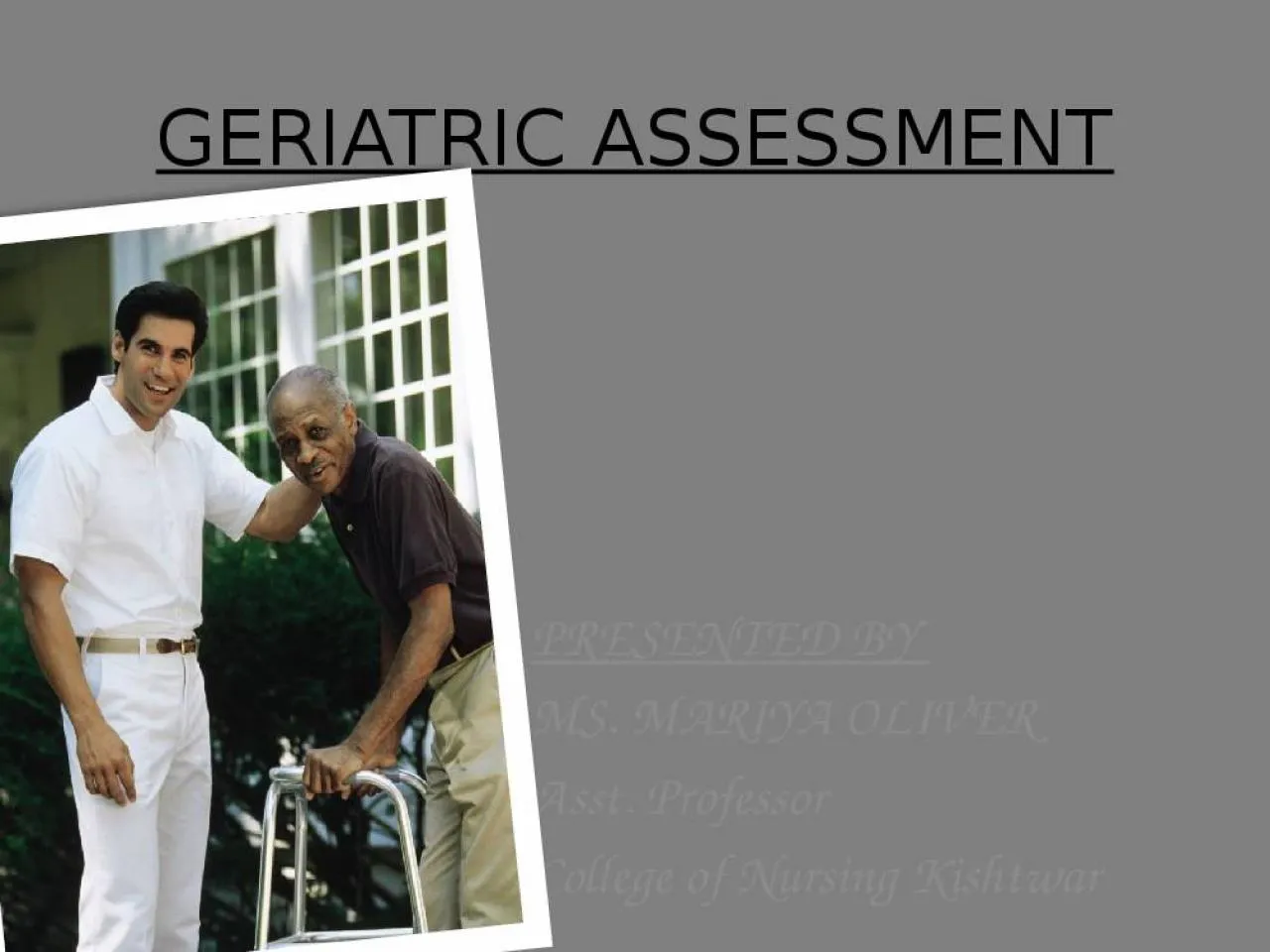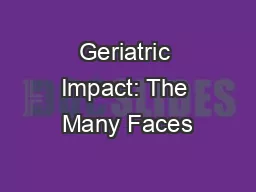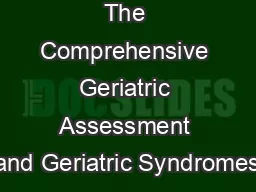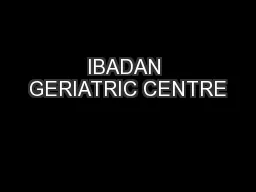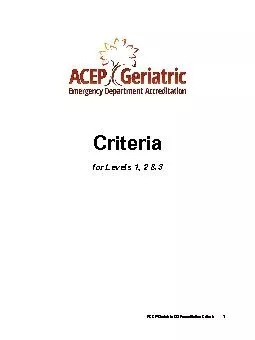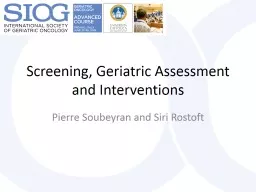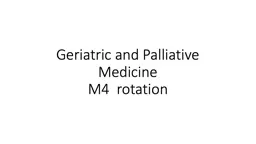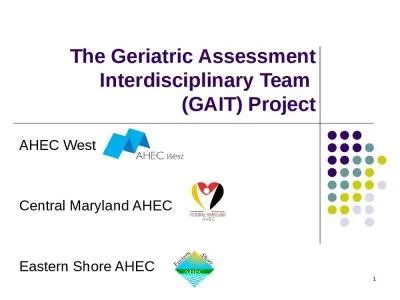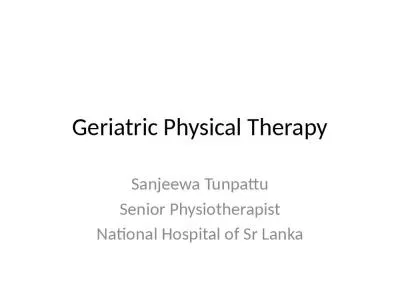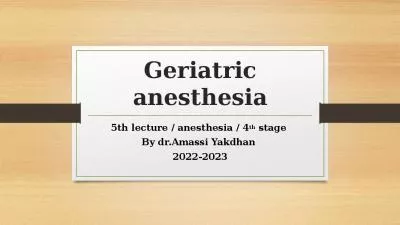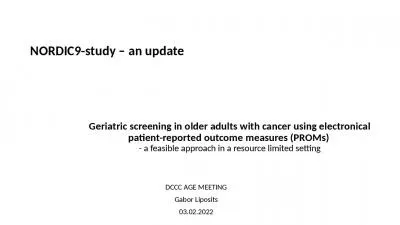PPT-GERIATRIC ASSESSMENT PRESENTED BY
Author : hadly | Published Date : 2022-02-10
MS MARIYA OLIVER Asst Professor College of Nursing Kishtwar HISTORY COLLECTION Establish a good rapport with the patient Establish the patients well being as your
Presentation Embed Code
Download Presentation
Download Presentation The PPT/PDF document "GERIATRIC ASSESSMENT PRESENTED BY" is the property of its rightful owner. Permission is granted to download and print the materials on this website for personal, non-commercial use only, and to display it on your personal computer provided you do not modify the materials and that you retain all copyright notices contained in the materials. By downloading content from our website, you accept the terms of this agreement.
GERIATRIC ASSESSMENT PRESENTED BY: Transcript
MS MARIYA OLIVER Asst Professor College of Nursing Kishtwar HISTORY COLLECTION Establish a good rapport with the patient Establish the patients well being as your primary concern Help the patient to promote his health . older . adults admitted to hospital. Clinical Case . and Discussion Questions. Created . by William E Cayley, . Jr. Journal Club Editor. Prevea. Family Medicine Residency. Bobbie is a 75 year old woman admitted to hospital for a non-displaced hip fracture after a fall at home when she tripped over a pet cat. . of Geriatric Delivery Services. Steven L. Phillips, MD. Medical Director Sanford Center for Aging. Professor of Clinical Internal Medicine. University of Nevada School of Medicine. Medicare Annual Wellness Visit. The University of Texas Health Science Center at Houston (UTHealth). Describe a Comprehensive Geriatric Assessment (CGA) and its importance to geriatric care.. Discuss the components of a CGA through case studies.. and . LONGTERM CARE FACILITIES IN IBADAN. , . NIGERIA. Dr.. ADEBUSOYE Lawrence. A. Director, Geriatric Centre. Ibadan, Nigeria. IBADAN GERIATRIC CENTRE. The Ibadan Geriatric . Centre . was commissioned . March 14, 2012. Overview. Current Geriatric Sarcopenia Screening, Diagnosis and Treatment Options. Medicare Coverage and Reimbursement Objectives. . Oncology. . The French model. Pierre Soubeyran. Institut . Bergonié. , Bordeaux, France. Disclosure. Research Support/P.I.. Honoraria. CELGENE, TEVA. Scientific Advisory Board. TEVA, . SANDOZ, BMS. ��ACEP Geriatric ED Accreditation Criteria Glossary of key termsAccreditation The process whereby an association or agency grants public recognition to a hospital , health care Pierre . Soubeyran. and Siri Rostoft. Disclosure. Research Support/P.I.. Roche, TEVA. Employee. No relevant conflicts of interest to declare. Consultant. No relevant conflicts of interest to declare. M4 rotation. Geriatric and Palliative Medicine . M4 Rotation. LOGISTICS. 4 Weeks. No Call. No nights or weekends. Memphis . Knoxville . Chattanooga. Geriatrics and Palliative Medicine Rotation. Memphis . (GAIT) Project. AHEC West. Central Maryland AHEC. Eastern Shore AHEC. 1. Funded by the Geriatrics & Gerontology Education and Research (GGEAR) program at University of Maryland, Baltimore Graduate School. Sanjeewa. . Tunpattu. Senior Physiotherapist. National Hospital of . Sr. Lanka. Objective. Discuss Physiotherapy considerations . applicable to age . related changes . Introduction. What . is Geriatric . Travis Suss, PharmD, BCGP. Objectives. Describe the background of the 'Geriatric Academic Career Award' (GACA) . Describe how GACA funds are being utilized to support professional development and interprofessional Geriatric training. th. stage . By . dr.Amassi. . Yakdhan. . 2022-2023. Geriatric anesthesia. Geriatric anesthesia. Respiratory system. Anatomy. ⬇️. chest wall compliance ⬆️rigidity.. Deformity of chest wall : scoliosis ,kyphosis .. 03.02.2022. Geriatric screening in older adults with cancer using electronical patient-reported outcome measures (PROMs) . - a feasible approach in a resource limited setting. NORDIC9-study – an . update.
Download Document
Here is the link to download the presentation.
"GERIATRIC ASSESSMENT PRESENTED BY"The content belongs to its owner. You may download and print it for personal use, without modification, and keep all copyright notices. By downloading, you agree to these terms.
Related Documents

